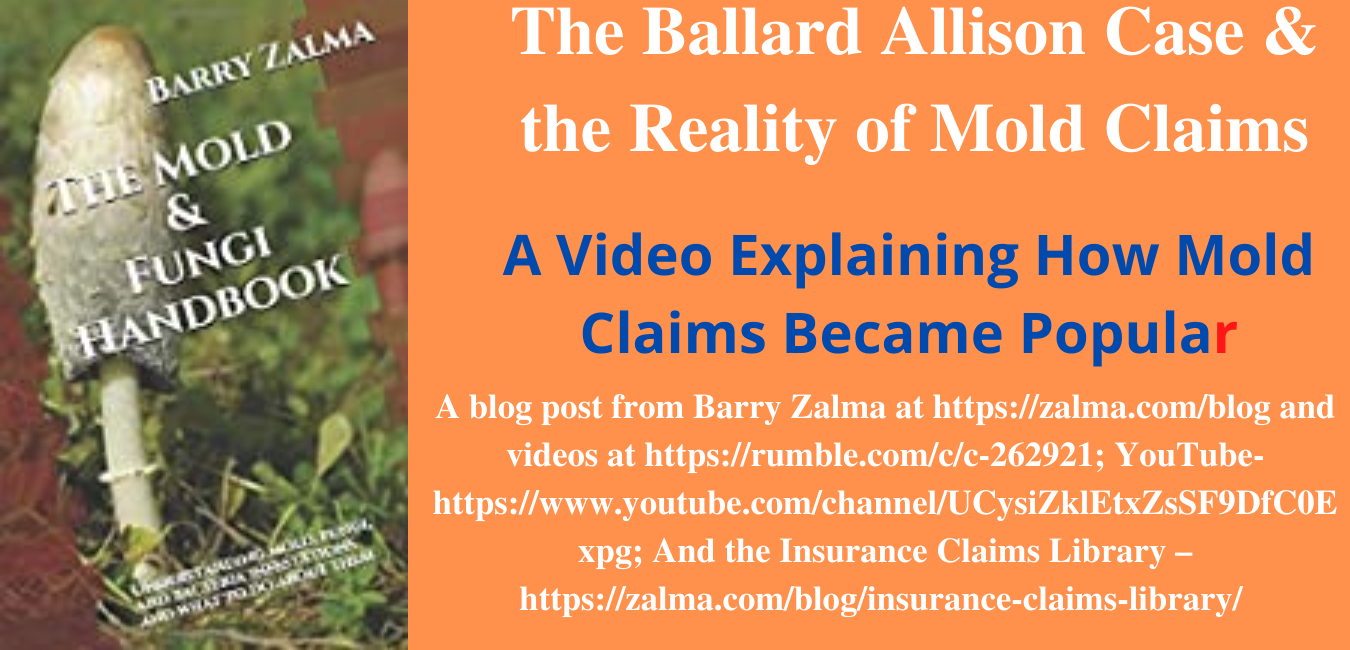Mold & the Ballard Allison Case & Bad Faith

A Video Explaining How Mold Claims Became Popular
Read the full article at https://www.linkedin.com/pulse/ballard-allison-case-reality-mold-claims-barry-zalma-esq-cfe and see the full video at https://rumble.com/vp2tmg-the-ballard-allison-case-and-the-reality-of-mold-claims.html?mref=23gga&mrefc=2 and at https://youtu.be/0Rp5VFcPBF4 and at https://zalma.com/blog plus more than 3950 posts.
The fear of mold claims was engendered in the insurance industry by the trial court decision in Ballard v. Fire Insurance Exchange, No. 99-05232 (Texas District Court, Travis County, June 1, 2001), cited in Jury Awards: $32 Million to Texas Homeowner in Mold Coverage Action, 6, No. 12, Mealey’s Emerging Insurance Disputes 11 (June 20, 2001 and “What Coverage Attorneys Need to Know About Mold,” Tort and Insurance Practice Law Journal, Fall 2002 (38:1), at page 45). The fear was mostly misplaced. The verdict was the result of poor claims handling. Almost the entire $32 million verdict was punitive damages that did not withstand appellate review.
The Texas Court of Appeals, Third District, at Austin, reversed much of the trial court’s opinion in Ronald Allison/Fire Insurance Exchange v. Fire Insurance Exchange, A Member of the Farmers Insurance Group/Mary Melinda Ballard and Ronald Allison, et. al, 98 S.W.3d 227 (2002), and explained the factual background that resulted in an improper and excessive judgment against the Fire Insurance Exchange (FIE). The Court of Appeals describe the evidence presented at trial in detail necessary to the understanding of the decision.
Although the Ballard Allison trial verdict was touted as a “mold” case, it was, in fact, a claims-handling case. The jury was offended by the admission that the adjuster, McConnell, lied to the insured and decided to punish them with excessive punitive damages.
The term “toxic mold” is not accurate. While certain molds are toxigenic, meaning they can produce toxins (specifically mycotoxins), the molds themselves are not toxic, or poisonous. Hazards presented by molds that may produce mycotoxins should be considered the same as other common molds which can grow in your house. There is always a little mold everywhere – in the air and on many surfaces. There are very few reports that toxigenic molds found inside homes can cause unique or rare health conditions such as pulmonary hemorrhage or memory loss. These case reports are rare, and a causal link between the presence of the toxigenic mold and these conditions has not been proven.
We are 100% funded for October.
Thanks to everyone who helped out. 🥰
Xephula monthly operating expenses for 2024 - Server: $143/month - Backup Software: $6/month - Object Storage: $6/month - SMTP Service: $10/month - Stripe Processing Fees: ~$10/month - Total: $175/month
- Art
- Causes
- Crafts
- Crime
- Dance
- Drinks
- Film
- Finance
- Fitness
- Food
- Игры
- Gardening
- Health
- Главная
- Literature
- Music
- Networking
- Paranormal
- Другое
- Politics
- Истории
- News
- Party
- Science
- Religion
- Shopping
- Sports
- SyFy
- Politically Incorrect
- Philosophy
- Theater
- Technology
- Wellness



